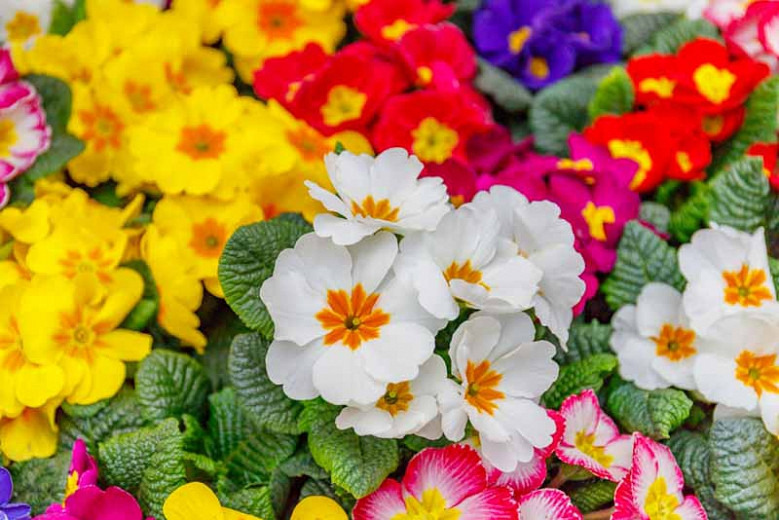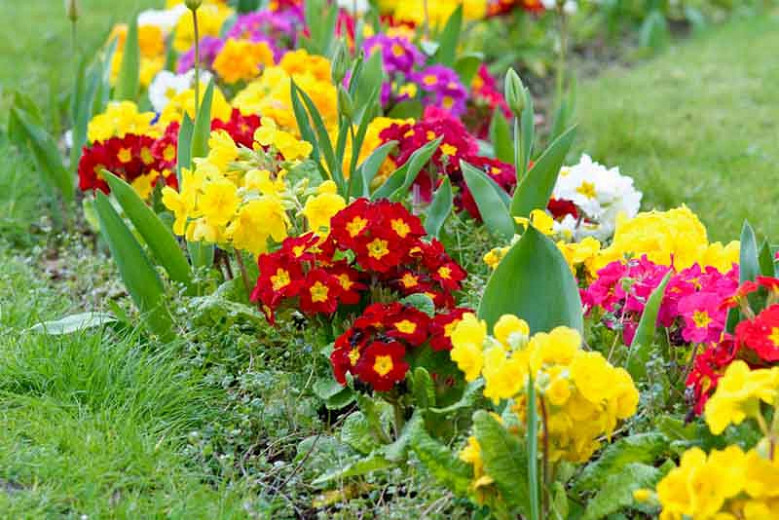Primroses, with their bright and cheerful flowers, are a welcome sight in gardens and outdoor spaces in the spring. These hardy plants are easy to grow and care for, making them a popular choice for gardeners of all skill levels. In this guide, we'll take a closer look at how to grow primroses in the spring, including tips on planting, soil preparation, watering, and fertilizing.

Understanding Primroses
Before we dive into the details of growing primroses, it's important to understand a bit about these plants. Primroses, also known as Primula, are a group of flowering plants that belong to the Primulaceae family. There are over 400 different species of primroses, with a wide variety of flower colors, shapes, and sizes.
Primroses are native to many parts of the world, including Europe, Asia, and North America. They typically grow in cool, moist environments, such as woodlands and meadows. In the garden, primroses prefer similar conditions, with well-draining soil and partial shade.
Planting Primroses
The first step in growing primroses is to choose the right location for planting. As mentioned, primroses prefer partial shade and moist, well-draining soil. They also prefer cooler temperatures, so it's best to avoid planting them in areas that get too hot or dry. When planting primroses, it's important to prepare the soil properly. This involves adding organic matter, such as compost or well-rotted manure, to improve soil structure and fertility. Primroses also benefit from a slightly acidic soil, with a pH range of 6.0 to 7.0. If your soil is too alkaline, you can add sulfur or aluminum sulfate to lower the pH.
Planting primroses is relatively straightforward. Dig a hole that is slightly larger than the root ball, and place the plant in the hole. Make sure that the top of the root ball is level with the soil surface, and backfill the hole with soil. Water the plant thoroughly after planting to help settle the soil around the roots.
Watering Primroses

Watering is an important aspect of growing primroses. These plants prefer moist soil, but they don't like to be waterlogged. Overwatering can lead to root rot and other problems, so it's important to water them correctly.
The key to watering primroses is to keep the soil consistently moist, but not saturated. This can be achieved by watering deeply once or twice a week, depending on the weather and soil conditions. If the soil is dry to the touch, it's time to water. On the other hand, if the soil is already moist, it's best to wait before watering again.
It's also important to water primroses at the base of the plant, rather than from above. This helps to avoid wetting the foliage, which can lead to fungal diseases. Using a soaker hose or drip irrigation system can be a good way to water primroses without getting the foliage wet.
Fertilizing Primroses
Fertilizing can help to promote healthy growth and flowering in primroses. However, it's important to use the right type of fertilizer, and to apply it at the right time.
In general, primroses benefit from a balanced, all-purpose fertilizer that contains equal amounts of nitrogen, phosphorus, and potassium. This type of fertilizer can be applied in the spring, just as the plant is beginning to grow. Be sure to follow the manufacturer's instructions for application rates and timing.
Another option is to use an organic fertilizer, such as fish emulsion or compost tea These types of fertilizers provide nutrients in a slow-release form, which can be beneficial for primroses. It's also important not to over-fertilize primroses, as this can lead to excessive growth and reduced flowering. Stick to the recommended application rates, and avoid applying fertilizer during periods of hot or dry weather, as this can cause damage to the plant.
Mulching Primroses
Mulching can help to conserve moisture, suppress weeds, and improve soil structure around primroses. A layer of organic mulch, such as bark chips or shredded leaves, can be applied around the base of the plant to a depth of 2-3 inches. This can help to keep the soil cool and moist, which is ideal for primroses.
When mulching around primroses, be careful not to bury the foliage or stem of the plant. This can lead to rot and other problems. Instead, keep the mulch several inches away from the base of the plant, and leave a small gap around the stem to allow air circulation.
Deadheading Primroses
Deadheading, or removing spent flowers, can help to promote continuous blooming in primroses. As soon as the flowers begin to fade, simply pinch or cut off the entire flower stem. This will encourage the plant to produce more flowers and extend the blooming period. Deadheading can also help to prevent the plant from setting seed, which can divert energy away from flower production. By removing spent flowers, you can help to keep the plant focused on producing new blooms.
Dividing Primroses
Over time, primroses can become crowded and may need to be divided to maintain healthy growth and flowering. This is typically done every few years, in the fall after the plant has finished blooming.
To divide primroses, carefully dig up the entire plant and gently separate the root clump into smaller sections. Each section should have several healthy shoots and roots. Replant these sections in prepared soil, and water thoroughly. Dividing primroses can help to rejuvenate the plant and promote new growth and flowering. It can also help to control the size of the plant, and prevent it from overcrowding its neighbors.
Common Problems and Solutions
Despite their hardiness, primroses can still be susceptible to a range of problems. Here are some common issues and solutions to keep in mind:
- Fungal diseases: Primroses can be susceptible to a range of fungal diseases, including powdery mildew and leaf spot. To prevent these diseases, avoid wetting the foliage when watering, and provide good air circulation around the plant. If disease does occur, remove infected leaves and treat with a fungicide if necessary.
- Aphids: Aphids can be a common pest on primroses, feeding on the sap and causing distortion and stunted growth. To control aphids, try spraying the plant with a strong jet of water, or treat with an insecticidal soap or neem oil.
- Slugs and snails: Slugs and snails can also be a problem for primroses, feeding on the foliage and leaving behind slimy trails. To control these pests, try using a slug bait or trap, or apply a copper strip around the base of the plant to repel them.
Growing primroses in the spring can be a rewarding and enjoyable experience. With the right care and attention, these hardy plants can produce a profusion of bright and colorful flowers, adding a splash of color to any garden or outdoor space. By following the tips and advice in this guide, you can help to ensure that your primroses thrive and flourish year after year.



















